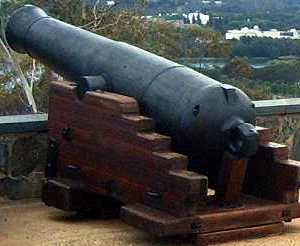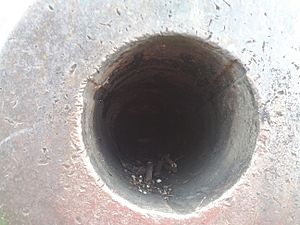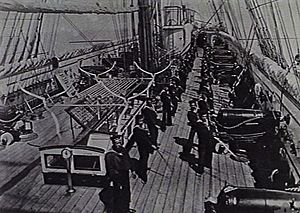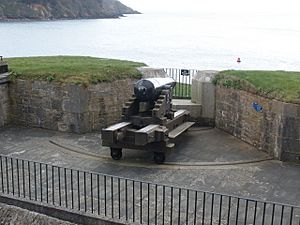RML 64-pounder 71 cwt gun facts for kids
Quick facts for kids Ordnance RML 64-pounder 71 cwt gun (converted) |
|
|---|---|

No. 398 made by Royal Gun Factory in 1870, at the Royal Australian Artillery Memorial, Canberra
|
|
| Type | Naval gun Coast defence gun |
| Place of origin | United Kingdom |
| Service history | |
| In service | 1870 – 190? |
| Used by | Royal Navy Australian Colonies |
| Production history | |
| Designed | 1870 |
| Manufacturer | Royal Arsenal |
| Specifications | |
| Mass | 7,896 pounds (3,582 kg) |
| Barrel length | 103.27 inches (2.623 m) (bore) |
|
|
|
| Shell | 64 pounds (29.03 kg) |
| Calibre | 6.29-inch (159.8 mm) |
| Muzzle velocity | 1,230 feet per second (370 m/s) |
The RML 64-pounder 71 cwt guns (converted) were powerful British cannons. They were called "rifled muzzle-loaders" (RML) because they had special grooves inside their barrels. These grooves made the cannonball spin, helping it fly straighter and farther. These guns were not built from scratch. Instead, they were old, outdated "smoothbore" cannons that were updated in the 1860s and 1870s.
Contents
How These Cannons Were Made
In the 1860s, Britain started using cannons with rifled barrels. They still had many older, smooth-barreled guns that were no longer useful. Making new cannon barrels was very expensive. So, engineers decided to update the best of the old guns.
They used a method created by William Palliser. This method involved putting a new, stronger tube of wrought iron inside the old cast iron barrel. This made the gun much stronger and ready for rifling.
The 64-pounder gun started as an 8-inch smoothbore cannon from 1834. This old gun was designed to fire a 50-pound round cannonball. To convert it, the inside of the 8-inch gun was drilled out to make it wider. Then, a new, strong iron tube was put inside. This new tube had an inner diameter of 6.29 inches.
After the new tube was in place, special spiral grooves were cut into its inside surface. This process is called "rifling." The grooves made the cannonball spin as it left the barrel, like a football thrown with a spiral. This spin helped the cannonball fly more accurately.
How the Gun Fired
The 64-pounder gun could fire three main types of ammunition:
- Common shell: Used against buildings or forts.
- Shrapnel shell: Filled with small balls, used against groups of soldiers or cavalry.
- Case shot: A can filled with many small metal balls, used for close-range attacks against soft targets.
To fire the gun, a silk bag filled with black powder was loaded into the barrel. A small copper tube, called a friction tube, was put into a hole at the back of the gun. A rope was attached to this tube. When the rope was pulled, the tube would ignite, causing the powder to explode and fire the gun.
Different types of fuzes could be used with the shells. Some fuzes made the shell explode at a certain time or distance. Others made it explode when it hit something. These guns fired slowly, usually about one shot every three minutes.
Where These Guns Were Used
These 64-pounder guns were first used on British warships around the world. But by 1886, they were not strong enough to fight against the new, heavily armored ships. So, they were taken off the ships and used for other purposes.
Many of these guns were then placed on land to defend coasts. They were set up in various locations in Britain and its colonies. They were mounted on different types of gun carriages, made of iron or wood. By 1902, these guns were considered too old for coast defense. Most of them were then taken apart and scrapped.
See also
- RML 64-pounder 64 cwt gun - another type of 64-pounder gun
- List of naval guns
Surviving Examples
Some of these historic guns can still be seen today:
- Gun number 142, made in 1869, is in St Helier, Jersey.
- Gun numbers 398 and 407 are at the Royal Australian Artillery Memorial in Mount Pleasant, Canberra, Australia.
- Gun number 483, made in 1870, is one of two at the Old Battery, Dartmouth Castle, Devon, UK.
- Gun number 574, made in 1871, is at the Royal Armouries, Fort Nelson, Hampshire.
- Gun number 581, made in 1871, is also at the Royal Armouries, Fort Nelson.
- Gun number 681, made in 1871, is at the Royal Armouries, Fort Nelson, Hampshire.
- Gun number 709, made in 1872, is at Southsea Castle, UK.
- Gun number 721, made in 1874, is at the old battery, Dartmouth Castle, Devon.
- A gun is located at Mays Hill Cemetery, Parramatta, New South Wales, Australia.
- A gun is outside the wardroom at HMNZS Philomel, Auckland, New Zealand.
- A gun on a locally-made carriage is at the Army Memorial Museum, Waiouru, New Zealand.
- A gun is at Fort St. Catherine, St George, Bermuda.





